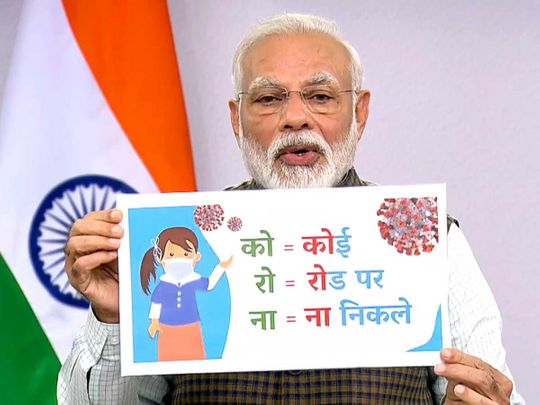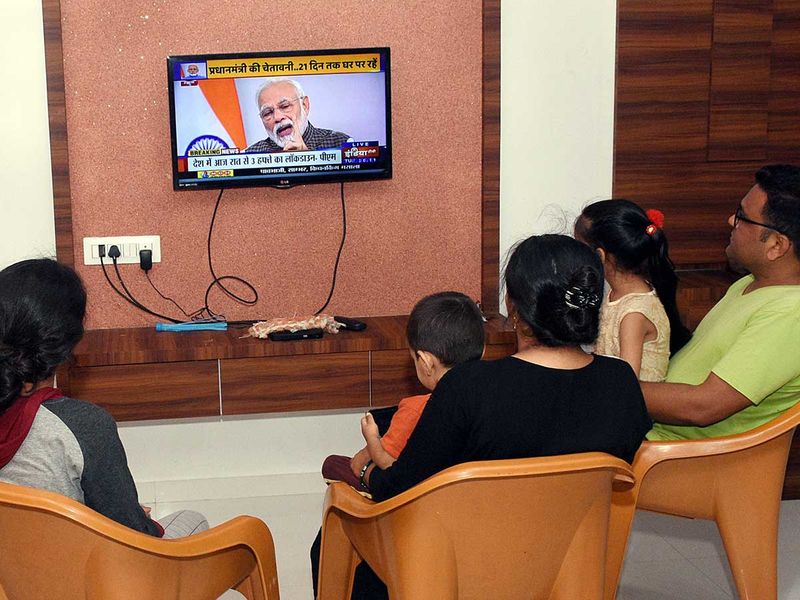
Since 2016, when Prime Minister Narendra Modi announced at a prime-time television address that he was withdrawing most of India’s currency overnight, such speeches have been preceded by wild speculation. Modi’s message on Tuesday evening was even starker than most expected. From midnight, this country of 1.3 billion will shut down: “For 21 days, forget what going out means.”
Modi is one of the world’s most accomplished politicians, a man who has demonstrated time and again his ability to understand exactly how to appeal to voters’ hearts and minds. But this pandemic will test even Modi’s hold over Indians. Earlier, he had called for a “people’s curfew” last Sunday, with a 5pm round of applause from balconies for health workers on the frontlines. In some parts of India, that turned into a farce — an excuse for celebration in the streets. Which is why, perhaps, in this speech he had to stress the danger of not observing strict social distancing: “Step outside in the next 21 days, and you set this country back 21 years.”
In some ways, Modi’s hand was forced. In spite of a puzzling unwillingness to roll out widespread testing, it had become clear that the virus was beginning to spread out of India’s hyper-globalised enclaves, and one state government after another had begun to impose curfews and lockdowns. By the time Modi spoke on TV, almost every Indian state had put major restrictions in place.
Whether the gamble succeeds or doesn’t, the India that emerges at the other end of these three weeks will be irrevocably changed.
Long-term lockdowns are difficult to implement anywhere, but in an India where so many need to work every day just to survive, they pose very special problems. You can’t lock down for too long — three weeks is already pushing the limit of what people will likely accept — and you can’t do it too often. So the question is whether India has been shut down too early, or too late.
Chances are, it’s the latter. The government was too slow to roll out testing, and the self-quarantine system for travellers had giant holes in it. Given how the novel coronavirus spreads — including through infected but asymptomatic people — a more active early approach seemed called for. Some state governments did well: The southern state of Kerala, for example, mapped out every possible contact of infected people, including which seat they may have sat in movie theatres.
But the federal government seemed frankly overconfident. In early February, the leader of the opposition Congress party said that assurances from the government that the virus was “under control” in India were “like the captain of the Titanic telling his passengers not to panic as his ship was unsinkable.” In response, the federal health minister said on Twitter that the opposition should not compare the coronavirus to “one of the deadliest peacetime marine disasters in history” and that the World Health Organisation said there was no need to panic. At moments like this we should feel governments know what they’re doing. This sort of response causes one to worry they don’t.

In any case, we could be more confident of the government’s response if India didn’t already have one giant example: What happened after that speech in 2016 that demonetised India’s currency. Whatever the merits of the idea — and there weren’t that many — the fallout revealed that the government’s political brilliance was not matched by organisational competence. Six months of chaos ensued. And then the government rolled out a new indirect tax regime similarly blighted by bad planning and worse implementation. Modi’s decisions can often be heroic in their aspirations, but very quickly derailed by the reality of the creaky Indian state and his own mediocre administration.
The success of this shutdown will depend upon the state’s capacity to monitor it. And India’s ability to survive these 21 days will depend upon the state’s ability to provide essential services to the large sections of the country that may not survive without them. In a country where migrant labourers might live a dozen to a room, a shutdown of this sort in fact asks unprecedented questions of the state. Will you shift these millions of people back home, risking the further spread of the virus? Will you hope that these crowded conditions don’t become hotbeds of transmission? And, most simply, how will you ensure that many members of India’s working class, who live off daily wages, will have enough to eat at the end of three months?
Modi may have felt he was left no choice, and his instincts are always to go as big as possible. Shutting down 1.3 billion people for 21 days is as big as it gets.
The Indian state will have to step up and be there for its people in ways it never has in history. Some parts of the country will do fine; state governments that took the lead in chasing down the virus will also probably manage world-class results when it comes to managing the lockdown. But others, particularly in poor and overpopulated northern India, may not do as well.
Modi may have felt he was left no choice, and his instincts are always to go as big as possible. Shutting down 1.3 billion people for 21 days is as big as it gets. Whether the gamble succeeds or doesn’t, the India that emerges at the other end of these three weeks will be irrevocably changed.
— Bloomberg
Mihir Sharma is a Bloomberg Opinion columnist. He is the author of Restart: The Last Chance for the Indian Economy.







